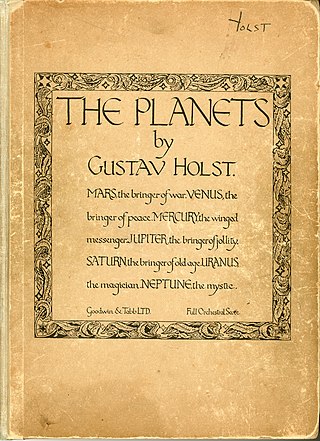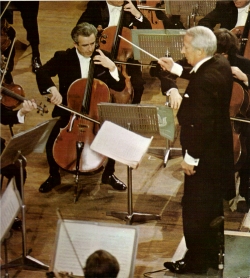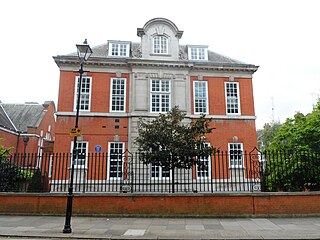Notes, references and sources
Notes
- ↑ Timings of recorded versions range from 12m 49s (Sir Adrian Boult/London Philharmonic Orchestra) and David Lloyd-Jones/Royal Scottish National Orchestra) to 16m 27s (Richard Hickox/London Symphony Orchestra). Between these extremes are recordings conducted by Sir Andrew Davis (13m 07s), Bramwell Tovey (14m 14s) and André Previn (14m 35s) [6]
Related Research Articles

Gustav Theodore Holst was an English composer, arranger and teacher. Best known for his orchestral suite The Planets, he composed many other works across a range of genres, although none achieved comparable success. His distinctive compositional style was the product of many influences, Richard Wagner and Richard Strauss being most crucial early in his development. The subsequent inspiration of the English folksong revival of the early 20th century, and the example of such rising modern composers as Maurice Ravel, led Holst to develop and refine an individual style.

The Planets, Op. 32, is a seven-movement orchestral suite by the English composer Gustav Holst, written between 1914 and 1917. In the last movement the orchestra is joined by a wordless female chorus. Each movement of the suite is named after a planet of the Solar System and its supposed astrological character.

Sir Adrian Cedric Boult, CH was a British conductor. Brought up in a prosperous mercantile family, he followed musical studies in England and at Leipzig, Germany, with early conducting work in London for the Royal Opera House and Sergei Diaghilev's ballet company. His first prominent post was conductor of the City of Birmingham Orchestra in 1924. When the British Broadcasting Corporation appointed him director of music in 1930, he established the BBC Symphony Orchestra and became its chief conductor. The orchestra set standards of excellence that were rivalled in Britain only by the London Philharmonic Orchestra (LPO), founded two years later.

Sir Granville Ransome Bantock was a British composer of classical music.

Imogen Clare Holst was a British composer, arranger, conductor, teacher, musicologist, and festival administrator. The only child of the composer Gustav Holst, she is particularly known for her educational work at Dartington Hall in the 1940s, and for her 20 years as joint artistic director of the Aldeburgh Festival. In addition to composing music, she wrote composer biographies, much educational material, and several books on the life and works of her father.
Ralph Vaughan Williams dedicated his Symphony No. 4 in F minor to Arnold Bax.
A London Symphony is the second symphony that Ralph Vaughan Williams composed. The work is sometimes referred to as Symphony No. 2, though the composer did not designate that name for the work. First performed in 1914, the original score of this four-movement symphony was lost and subsequently reconstructed. Vaughan Williams continued revisions of the work into its final definitive form, which was published in 1936.
Vernon George "Tod" Handley was a British conductor, known in particular for his support of British composers.
Ralph Vaughan Williams composed his Symphony in E minor, published as Symphony No. 6, in 1944–47, during and immediately after World War II and revised in 1950. Dedicated to Michael Mullinar, it was first performed, in its original version, by Sir Adrian Boult and the BBC Symphony Orchestra on 21 April 1948. Within a year it had received some 100 performances, including the U.S. premiere by the Boston Symphony Orchestra under Serge Koussevitzky on 7 August 1948. Leopold Stokowski gave the first New York performances the following January with the New York Philharmonic and immediately recorded it, declaring that "this is music that will take its place with the greatest creations of the masters." However, Vaughan Williams, very nervous about this symphony, threatened several times to tear up the draft. At the same time, his programme note for the first performance took a defiantly flippant tone.

Egdon Heath is a fictitious area of Thomas Hardy's Wessex inhabited sparsely by the people who cut the furze (gorse) that grows there. The entire action of Hardy's novel The Return of the Native takes place on Egdon Heath, and it also features in The Mayor of Casterbridge and the short story The Withered Arm (1888). The area is rife with witchcraft and superstition.

Cockaigne (In London Town), Op. 40, also known as the Cockaigne Overture, is a concert overture for full orchestra written by the British composer Edward Elgar in 1900–1901.

Sāvitri is a chamber opera in one act with music composed by Gustav Holst, his Opus 25, to his own libretto. The story is based on the episode of Savitri and Satyavan from the Mahābhārata, which was also included in Specimens of Old Indian Poetry and Idylls from the Sanskrit. The opera features three solo singers, a wordless female chorus, and a chamber orchestra of 12 musicians. Holst had made at least six earlier attempts at composing opera before arriving at Sāvitri.
Roderick Gregory Coleman Williams OBE is a British baritone and composer.
Beni Mora is a three-movement suite of music in E minor for large orchestra, by Gustav Holst. The first performance was at the Queen's Hall, London, on 1 May 1912, conducted by the composer. The work was inspired by music Holst heard in Algeria during a holiday in 1908. The constant repetition of one theme from Arabic folk music in the last movement has been described as a precursor of modern minimalism. The piece also includes dance rhythms and wistful, slow sections, and makes strong use of woodwinds and percussion. Beni Mora has been recorded several times by British orchestras, most recently in 2011.

"This Have I Done for My True Love", or "Tomorrow Shall Be My Dancing Day", Op. 34, no. 1 [H128], is a motet or part song composed in 1916 by Gustav Holst. The words are taken from an ancient carol, and the music is so strongly influenced by English folk music that it has sometimes been mistaken for a traditional folk song itself. It has often been described as a small masterpiece.

Hammersmith: Prelude and Scherzo, more commonly known as just Hammersmith, Op. 52, is a wind band work composed by English composer Gustav Holst in 1930, with a corresponding orchestral version. Commissioned by the BBC Military Band, the piece is based on Holst's love for the London borough of Hammersmith. The writing is more musically challenging than Holst's other wind band works, and is a wind band essential today. A typical performance runs for 14 minutes.
The Double Concerto for Two Violins and Orchestra is a work by Gustav Holst in three movements played without a break. It was written in 1929 and first performed in 1930 by its dedicatees, the sisters Adila Fachiri and Jelly d'Arányi. Though now praised by many critics, it has never been frequently performed in the concert hall. It is characterized by fugal counterpoint, folk-like melody, and bitonality without dissonance.
The Lyric Movement for viola and small orchestra is a short concertante work by Gustav Holst. It was one of his last compositions, being written in 1933. It was first performed in 1934, the year of his death, by its dedicatee, the violist Lionel Tertis, and the BBC Symphony Orchestra conducted by Adrian Boult. Though its early performers found the Lyric Movement too austere for their tastes, it has more recently been considered one of Holst's most successful later works. It has been recorded several times.
A Fugal Overture, Op. 40/1, H 151, is a short concert overture for full orchestra by the English composer Gustav Holst. It was written in 1922 and first performed in 1923, and is a very early example of musical neoclassicism. Though there were conflicting opinions from Holst's contemporaries about the work's merits, it has since come to be considered an attractive and exciting, if slight, example of Holst's later style.
A Fugal Concerto by the English composer Gustav Holst is a short concerto in three movements for flute, oboe and string orchestra. It was composed and first performed in 1923. Influenced by the counterpoint of J. S. Bach, it is an early example of neoclassicism. Early reviews of the concerto were mixed, but it has since come to be seen as an attractive, if slight, example of Holst's neoclassical style, and it has been recorded many times.
References
- ↑ Taylor, p. 69
- ↑ Foreman, p. 6
- ↑ Holst, p. 71
- ↑ Morrison, Chris. "Gustav Holst: Egdon Heath" Allmusic. Retrieved 3 March 2015
- ↑ Cooke, Phillip. "On Gustav Holst’s Egdon Heath" [ permanent dead link ], philipcooke.com]. Retrieved 3 March 2015
- ↑ Liner notes to Decca ELQ4802323 (Boult), Naxos 8.553696 (Lloyd-Jones), Teldec 825646740208 (Davis), CBC SMCD5176 (Tovey), EMI 0724356261655 (Previn) and Chandos CHAN9420 (Hickox)
- ↑ Holst, p. 70
- 1 2 3 4 Adams, Byron. "Review: Egdon Heath, for Orchestra, Op. 47 by Gustav Holst; Occasional Overture (1946), for Orchestra by Benjamin Britten", Notes, Second Series, Vol. 45, No. 4 (June 1989), pp. 850–852 DOI: 10.2307/941241 (subscription required)
- ↑ Holst, p. 72
- ↑ "Royal Philharmonic Society", The Times, 24 February 1928, p. 12
- ↑ "Holst's Egdon Heath", The Manchester Guardian, 24 February 1928, p. 10
- ↑ Evans, Edwin. "Gustav Holst September 21, 1874 – May 25, 1934", The Musical Times, Vol. 75, No. 1097 (July 1934), pp. 593–597 (subscription required)
- ↑ "Egdon Heath", WorldCat. Retrieved 3 September 2021
- ↑ "Civilization V Music Credits". Archived from the original on 26 March 2018.
Sources
- Foreman, Lewis (1996). Notes to Chandos CD CHAN9420. Colchester: Chandos. OCLC 815453876.
- Holst, Imogen (1969). Gustav Holst (second ed.). London and New York: Oxford University Press. ISBN 978-0-19-315417-9.
- Taylor, Kevin (28 November 2013). Hans Urs von Balthasar and the Question of Tragedy in the Novels of Thomas Hardy. London and New York: Bloomsbury; T & T Clark. ISBN 978-0-567-21625-0.